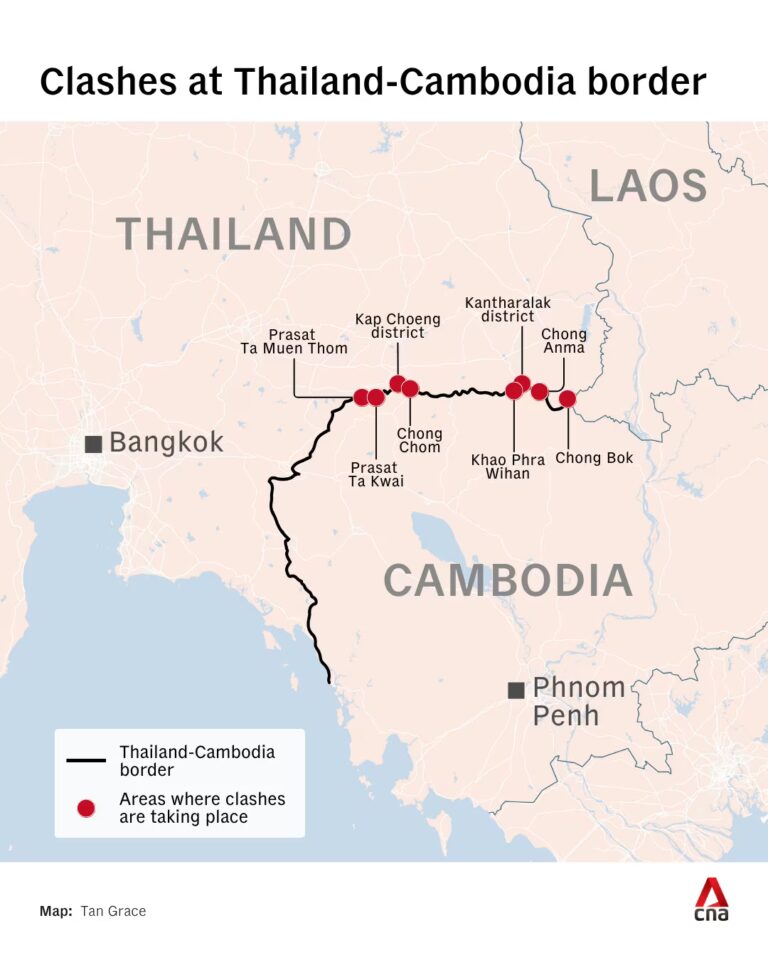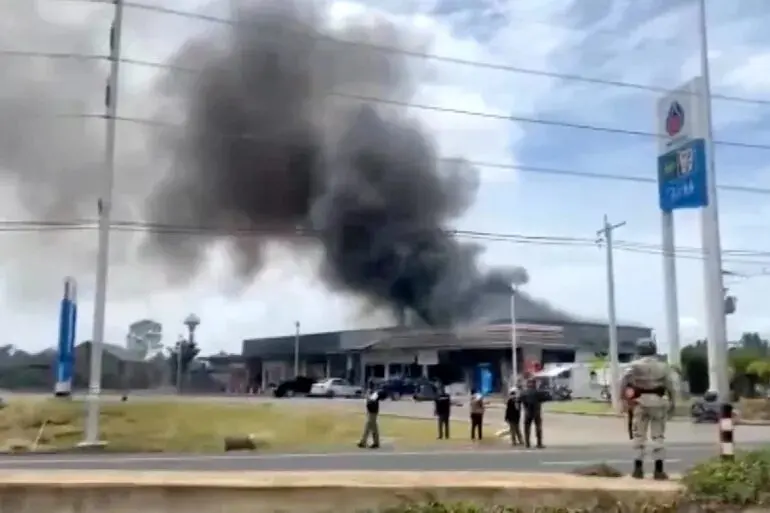7 Deadly Days: 5 Critical Truths About the Escalating Thailand-Cambodia Border Conflict

Thailand-Cambodia border conflict map 26/7/2025 Photo: International Press
July 26, 2025 Hour: 1:26 pm
At least 33 dead and over 160,000 displaced—explore the roots and risks of the renewed Thailand-Cambodia border conflict threatening Southeast Asian stability.
Related: Thai Airstrike Kills Civilians as Border Conflict with Cambodia Intensifies
7 Deadly Days: 5 Critical Truths About the Escalating Thailand-Cambodia Border Conflict
A deadly escalation along the Thailand-Cambodia border has left at least 33 people dead, dozens injured, and over 160,000 civilians displaced—marking the most severe outbreak of violence between the two nations in more than a decade. As of July 27, 2025, the Thailand-Cambodia border conflict entered its third consecutive day of intense fighting, with both sides deploying artillery, tanks, and fighter jets in clashes centered around contested temple zones, including Ta Muen Thom and Preah Vihear.
The crisis, rooted in a colonial-era territorial dispute, has reignited fears of prolonged regional instability in Southeast Asia, a region that has largely maintained peace through diplomatic integration under ASEAN. But with diplomatic ties now severed and humanitarian conditions deteriorating rapidly, the world is watching closely.
The Thailand-Cambodia border conflict is not just a bilateral dispute—it’s a test of regional diplomacy, humanitarian response, and international law.
The fighting erupted on July 24, 2025, after Thailand accused Cambodian forces of triggering a landmine explosion that injured five soldiers in Ubon Ratchathani province. Phnom Penh immediately denied responsibility, instead accusing Thailand of launching an unauthorized military incursion into Cambodian territory—claims both nations continue to dispute.
Within hours, artillery fire echoed across the border, forcing thousands to flee their homes. The United Nations has confirmed civilian casualties, including women and children, and warns that the humanitarian toll could rise sharply if hostilities continue.
The Roots of the Thailand-Cambodia Border Conflict: History, Maps, and Temples
To understand the current crisis, one must look back to 1907, when French colonial authorities drew a map delineating the border between French Indochina (modern-day Cambodia) and Siam (modern-day Thailand). That map, based on incomplete surveys, placed several ancient Khmer temple complexes—including Preah Vihear—on the Cambodian side.
When Cambodia gained independence in 1953, it invoked this map to assert sovereignty over the temples. Thailand contested the decision, leading to a case before the International Court of Justice (ICJ) in 1962. The court ruled in Cambodia’s favor, affirming its ownership of Preah Vihear.
The ICJ ruling settled the legal question—but not the emotional and nationalistic tensions tied to sacred heritage sites.
Despite the verdict, the area remained a flashpoint. In 2008, UNESCO’s designation of Preah Vihear as a World Heritage Site reignited tensions, sparking military standoffs and deadly skirmishes that left dozens dead.
The current conflict centers not only on Preah Vihear, but also on Ta Muen Thom, a lesser-known temple complex that lies in a strategically sensitive corridor. Both nations claim historical and cultural ownership, making compromise politically difficult.
Over the past decade, tensions simmered under ASEAN-mediated dialogues, but without a permanent demarcation agreement. Now, that fragile calm has shattered.
External Link: ICJ Judgment – Temple of Preah Vihear (1962)
External Link: UNHCR Emergency Response – Thailand-Cambodia Crisis, 2025
Humanitarian Crisis: 160,000 Displaced Amid Shelling and Fear
The human cost of the Thailand-Cambodia border conflict is staggering. Over 160,000 civilians—mostly farmers, traders, and indigenous communities—have been forced to flee their homes in Sisaket (Thailand) and Oddar Meanchey (Cambodia) provinces. Makeshift camps have sprung up near Surin and Siem Reap, with limited access to clean water, food, and medical care.
This is not just a military conflict—it’s a fast-moving humanitarian emergency with children, elderly, and sick at highest risk.
The United Nations Office for the Coordination of Humanitarian Affairs (OCHA) has called for immediate humanitarian corridors to deliver aid, but ongoing shelling and unclear ceasefire lines make relief operations dangerous.
Local hospitals are overwhelmed. In Svay Chek, Cambodia, a clinic reported treating over 50 wounded, including civilians caught in crossfire. In Thailand, the military has set up emergency triage centers, but supplies are running low.
The psychological toll is equally severe. Families are separated, livelihoods destroyed, and entire villages abandoned. Many refugees speak of hearing explosions all night and fearing for their lives with no end in sight.
Geopolitical Context: ASEAN’s Test of Unity and Regional Stability
The Thailand-Cambodia border conflict is more than a bilateral issue—it’s a crisis for ASEAN, the 10-member regional bloc that has long prided itself on conflict prevention and economic integration.
Both countries are founding members of ASEAN, which promotes the “ASEAN Way”—a doctrine of non-interference, consensus, and peaceful dispute resolution. But as violence escalates, critics argue that ASEAN has been too slow, too passive, and lacks enforcement mechanisms to stop wars between its own members.
If ASEAN cannot mediate between Thailand and Cambodia, its credibility as a regional stabilizer is at risk.
The bloc has issued statements calling for restraint, but has not yet deployed envoys or peace monitors. Meanwhile, China and Vietnam have urged dialogue, while the United States and European Union have called for an immediate ceasefire and respect for international law.
The UN Security Council held an emergency closed-door session on July 26, where Cambodia’s ambassador, Chhea Keo, demanded an unconditional ceasefire and renewed efforts to resolve the dispute peacefully. The UN spokesperson, Stephanie Tremblay, described the situation as “the most serious escalation in over a decade.”

Military Tactics and Regional Risks: A Conflict That Could Spiral
The scale of military engagement is alarming. Satellite imagery analyzed by regional defense monitors shows Thai fighter jets conducting reconnaissance and strike missions, while Cambodian forces have deployed heavy artillery and anti-aircraft units near the border.
Both nations possess modern arsenals, including Russian and Chinese-made weapons, raising concerns about foreign influence and arms proliferation.
If air combat intensifies or cyber operations are deployed, the conflict could rapidly spiral beyond its current scope.
There are also fears of proxy dynamics—with external powers indirectly supporting one side. China, a major investor in Cambodia’s infrastructure, has deep strategic ties with Phnom Penh. Thailand, meanwhile, remains a key U.S. ally in the region.
While neither Beijing nor Washington has taken sides publicly, the conflict risks becoming a new front in the broader Indo-Pacific rivalry, especially as ASEAN struggles to maintain neutrality.
Possible Solutions: Diplomacy, Demarcation, and International Oversight
Despite the gravity of the situation, pathways to peace remain open. Experts and diplomats suggest a five-point plan to de-escalate:
- Immediate bilateral ceasefire, monitored by ASEAN or the UN.
- Deployment of neutral observers to verify troop withdrawals.
- Resumption of joint boundary demarcation based on the 1907 map and ICJ rulings.
- Establishment of humanitarian corridors for aid delivery and civilian protection.
- Regional peace conference under ASEAN-UN auspices to address root causes.
Lasting peace requires more than a ceasefire—it demands a permanent solution to a century-old border ambiguity.
The Preah Vihear temple could even be transformed into a joint heritage site, symbolizing reconciliation rather than division—similar to the UNESCO-led model at the Thai-Cambodian border in 2013.
But for now, the guns have not fallen silent.
Conclusion: A Region at a Crossroads
The Thailand-Cambodia border conflict stands as a stark reminder that even long-standing disputes can explode without warning. Behind the statistics—33 dead, 160,000 displaced—are families torn apart, histories weaponized, and futures erased.
This is not just about land or temples. It’s about national pride, historical memory, and the failure of diplomacy to keep pace with rising nationalism.
As ASEAN, the UN, and global powers respond, the world must ask: Can regional institutions prevent war before it starts? Can ancient grievances be resolved without bloodshed?
The answer will shape the future of Southeast Asian peace for generations.
The Thailand-Cambodia border conflict is a warning—not just to two nations, but to the entire world—about the cost of unresolved disputes.
Internal Link: /preah-vihear-temple-dispute
External Link: ASEAN Statement on Thailand-Cambodia Tensions – July 2025
Ready for publication.
Author: JMVR
Source: Al Mayadeen

